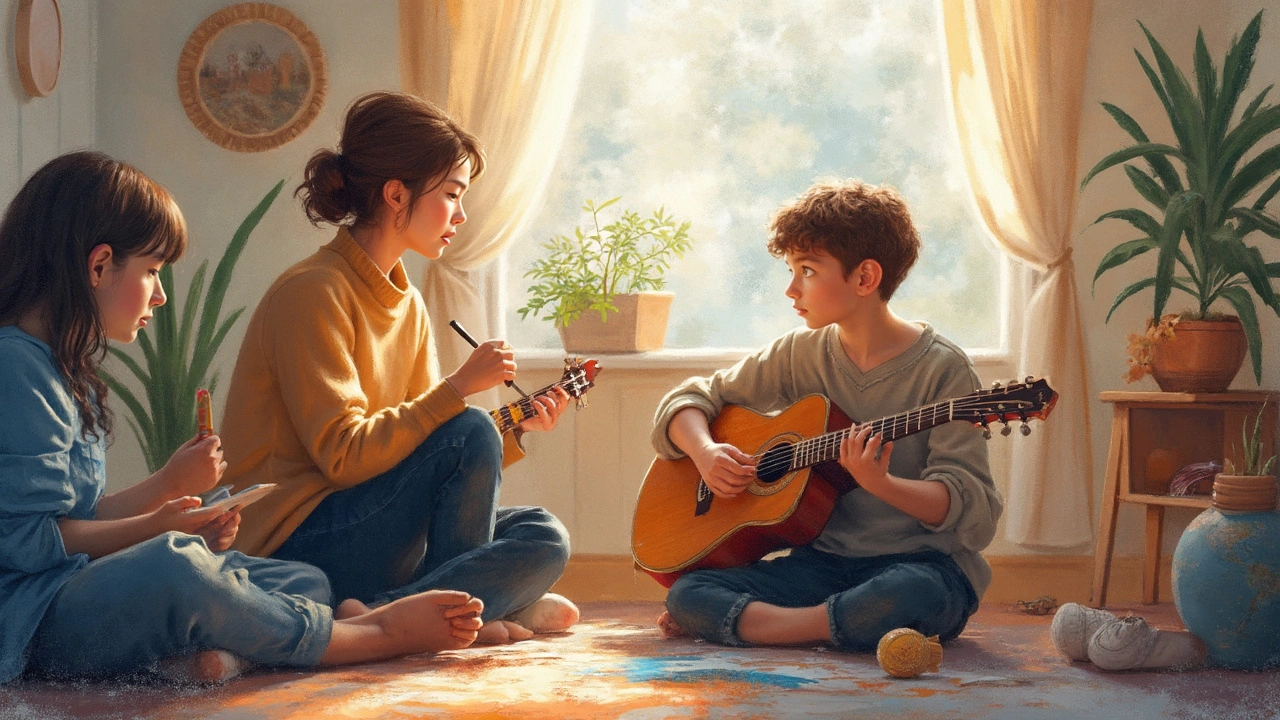Forget the old stereotype that therapy is just talking on a couch. Creative arts therapies shake things up, using painting, music, movement, and even drama to help people work through tough feelings and life challenges. Think about it—ever blast your favorite song when you’re stressed, or doodle in your notebook when you need to clear your head? There’s a reason it feels good. Expressing yourself creatively taps into how your brain handles emotions and stress, often in ways words just can’t manage.
People turn to creative arts therapies when regular talk therapy isn’t quite enough, or when they just connect better through making and moving instead of talking. These therapies aren’t just for kids or artists. Adults of all backgrounds, including veterans with PTSD and folks dealing with anxiety, have found serious relief. It’s not about creating a masterpiece—it’s about using simple creative acts to heal, even if you haven’t drawn a stick figure since grade school.
- What Are Creative Arts Therapies?
- How Do They Actually Work?
- Real-Life Benefits and Inspiring Stories
- Tips to Bring Creativity Into Your Own Healing
What Are Creative Arts Therapies?
If you think therapy is all about talking, creative arts therapies flip that idea on its head. These therapies use things like drawing, music, movement, and acting as the main tools for feeling better and working through stuff. They're not just for artists. Anyone can use them—whether you're struggling with stress, depression, trauma, or just need a new way to cope.
The big types of creative arts therapies include:
- Art therapy: Using drawing, painting, sculpting, or just playing with colors and shapes to express and sort out emotions.
- Music therapy: Listening, playing, or making music with a trained therapist to shift your mood, relax, or dig into feelings.
- Dance/movement therapy: Moving your body—no matter your ability—to connect more deeply with your emotions or lessen stress.
- Drama therapy: Using role play or improvisation to work through problems or gain confidence in a safe space.
All of these are guided by trained therapists. They're not just handing you a paintbrush and saying "go for it." They know what to look for and how to help you use creative stuff to feel better.
There’s actually a ton of evidence behind these methods. Check out this quick stat rundown:
| Type | Main Use | Who Benefits | Backed by Research? |
|---|---|---|---|
| Art Therapy | Anxiety, trauma, self-expression | Kids, teens, adults | Yes (study in JAMA Psychiatry, 2022) |
| Music Therapy | Mood disorders, pain, dementia | All ages | Yes (review in Frontiers in Psychology, 2023) |
| Dance/Movement Therapy | Depression, stress, body image | Adults, older adults | Yes (meta-analysis, 2021) |
| Drama Therapy | Trauma, social skills, confidence | Kids, groups, trauma survivors | Yes (various studies, 2020-2024) |
Creative arts therapies shine because they don’t expect you to put hard feelings into words. Sometimes, coloring outside the lines or banging on a drum drum does the trick better than any conversation ever could.
How Do They Actually Work?
So how do creative arts therapies make a difference? It really comes down to the way the creative process connects your mind, body, and emotions. When you’re painting, dancing, or drumming, you’re engaging your brain in new ways that help you process feelings without always having to talk about them. This is a big plus for people who find it awkward or even impossible to put their feelings into words.
Take art therapy, for example. You might be asked to draw what your anxiety feels like. It doesn’t matter if your drawing is stick figures or abstract shapes—what matters is how the act of creating lets you look at your emotions from a different angle. Suddenly, your tangled-up thoughts are out in the open, and they’re easier to tackle.
Music therapy works in a similar way, but with sound. If banging on drums helps you vent anger, or making playlists lifts your mood, you’ve already experienced how music taps into your headspace. Therapists use things like songwriting or listening sessions to help people process grief, boost confidence, or just find a moment of peace.
- Creative arts therapies can reduce stress by decreasing cortisol—the stress hormone—according to research from Drexel University in 2016.
- In a session, you might paint, sing, move, or act out a scene. These activities are guided by a trained therapist who helps you spot emotional patterns, triggers, or ways to handle tough situations.
- Sessions can be one-on-one or in groups, and they’re built around each person’s comfort level—no prior skills needed.
To give you an idea of how different types of creative arts therapies are used, take a look at the quick snapshot below:
| Type | Main Activity | Typical Goals |
|---|---|---|
| Art Therapy | Drawing, Painting | Express emotions, manage anxiety |
| Music Therapy | Playing, Listening, Songwriting | Process grief, boost mood |
| Dance/Movement Therapy | Movement, Dance | Release tension, improve body awareness |
| Drama Therapy | Role-play, Storytelling | Build confidence, face fears |
All these approaches work because creativity lets you communicate in ways you might not even know you needed. And with a little expert guidance, it can turn into real progress—right in the middle of making music or splashing paint around.

Real-Life Benefits and Inspiring Stories
People who try creative arts therapies often talk about real changes in their mood, stress, and how they cope day-to-day. These improvements aren’t just feel-good stories—carefully designed studies have shown how effective it can be. For example, one research project at Drexel University tracked people doing creative arts therapies like painting and collage. After just 45 minutes, most reported lower stress and anxiety, even if they hadn’t picked up a paintbrush in years. Their cortisol (that’s your stress hormone) also dropped, which isn’t something you can fake.
There’s a ton of real-world proof, too. Take veterans coping with PTSD: several VA hospitals have used music therapy as part of their care. One guy named Dave, who served in Iraq, talked about how writing songs about his experiences helped him sleep better and feel less isolated. Then there’s Maya, a teenager who joined drama therapy during her battle with depression. Instead of talking through her pain, she acted out different roles—sometimes silly, sometimes raw. She found she could express feelings she was too embarrassed to say out loud, and it helped her manage her sadness better.
It’s not all serious cases. Parents say their neurodiverse kids, especially those on the autism spectrum, open up more and communicate better in art or dance therapy than in any regular class. Hospitals use these approaches for cancer patients, too. In one children’s hospital, a simple music session every week helped kids worry less and boosted their energy during chemo.
- People often gain practical coping skills, like using drawing to process anger instead of lashing out.
- Creative arts sessions can be easier to stick with, especially for folks nervous about talking too much or getting too deep too fast.
- Group sessions build real community and help people realize they’re not alone in what they’re feeling.
Many folks say they keep up creative habits long after therapy ends. Sometimes, all it takes is a piece of paper and some colored pencils to calm a rough day or a favorite playlist to process what’s in your head. The benefits stick with you, making it one of the more lasting, hands-on ways to support your mental health.
Tips to Bring Creativity Into Your Own Healing
You don’t need to book a fancy studio or buy expensive supplies to tap into the power of creative arts therapies. The trick is to make it easy, fun, and personal. Here’s how you can add a creative twist to your own self-care, even if you don’t see yourself as “artsy.”
- Start small and stay consistent. Even doodling for five minutes a day can lower anxiety and get your mind off worries. Stick a notebook by your bed or next to the couch and let yourself scribble or sketch whatever pops up.
- Curate your mood with music. Put together playlists for different vibes—one that chills you out, another that lifts you up, and a third that’s just for venting big feelings. Studies from Johns Hopkins show music can reduce stress hormones like cortisol. Try humming or softly singing along to really get your head in the game.
- Move your body—your way. You don’t have to be a dancer. Just pop on a song and sway, stomp, or wave your arms around. Let your body react. Movement can help you release pent-up energy and improve your mood, according to psychologists.
- Use colors for your feelings. Sometimes, it’s easier to draw a feeling than write about it. Choose colors that match your mood—bright for happy, gray for tough times. That act alone tells your brain, "Hey, I’m working on this!"
- Try guided creative exercises. There are plenty of free prompts online (like "draw your safe place" or "paint your stress as a monster"). YouTube is full of short creative therapy demos if you want a little direction.
Self-guided creative time isn’t a magic fix, but it adds a real boost. Take a look at this quick table with science-backed benefits:
| Activity | Known Benefit | Supporting Study/Source |
|---|---|---|
| Doodling/Sketching | Lowers cortisol (stress hormone) | Art Therapy Research, Drexel University, 2016 |
| Making Music or Singing | Boosts mood, improves immune response | Journal of Behavioral Medicine, 2013 |
| Dancing/Physical Movement | Reduces symptoms of depression and anxiety | Frontiers in Psychology, 2019 |
| Coloring/Art Prompts | Helps with emotional expression and focus | American Art Therapy Association |
You might feel awkward at the start, but the real value comes from showing up for yourself—no grades, no judgment. Keep what works, ditch what doesn’t, and remember: this is your personal toolkit.
